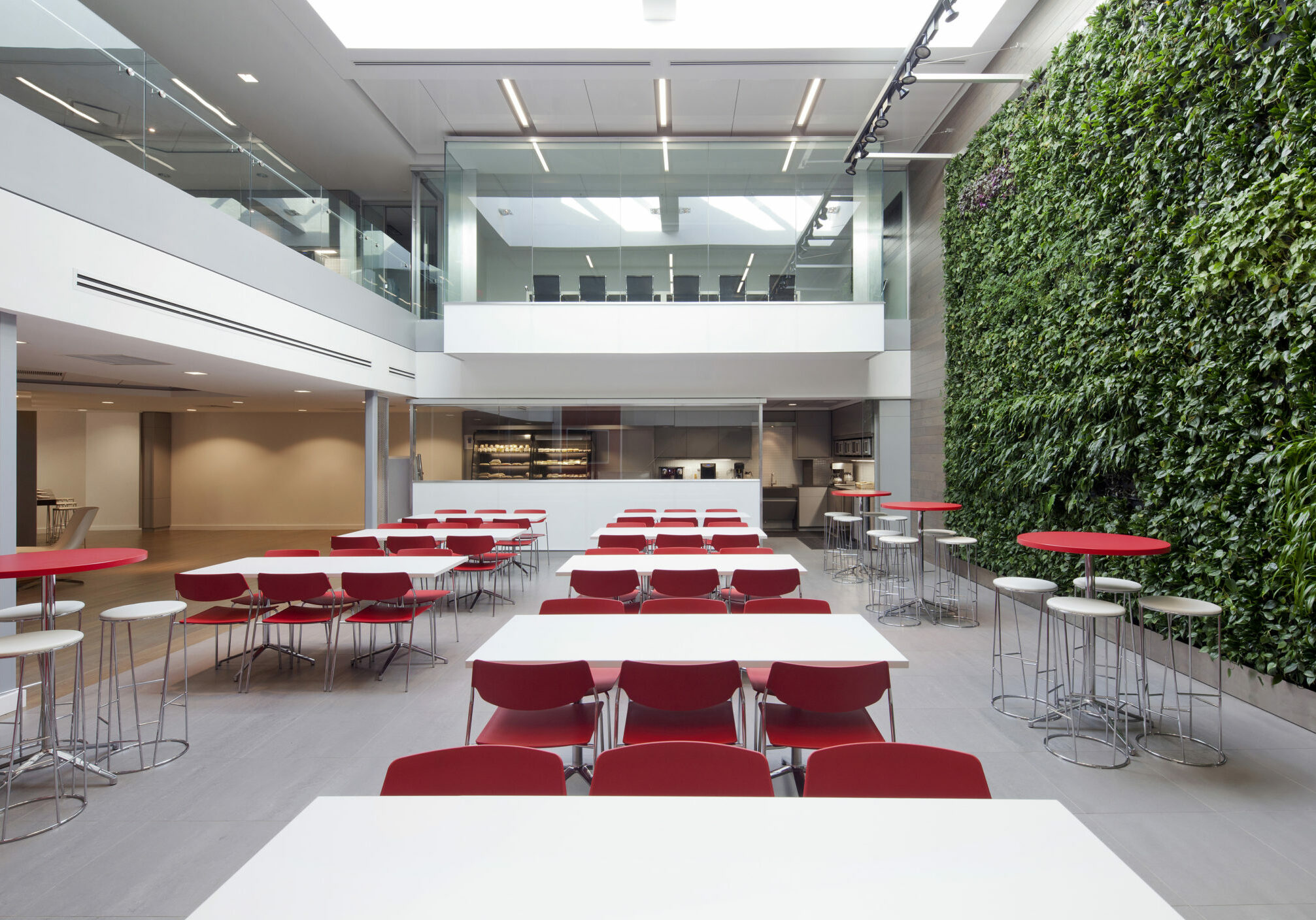
What Does Modern Office Interior Design Look Like?
Contemporary office interiors set a business up for success. With the right hand in the design, a modern office can inspire a workforce, instill trust in clients, and foster a comfortable atmosphere for all. In New York, Mojo Stumer is a purveyor of modern office interior design. Our work has assisted major corporations in creating world-class contemporary office interiors to reflect both company values and missions. A modern office should be personal, providing a safe space for people to openly share ideas while flowing traffic from one room to another. Modern office interior design must work in tandem with the existing architecture to promote the most efficient layouts for productivity. Mojo Stumer’s team of architects and interior designers work together to create one-of-a-kind contemporary office interiors, and this blog will highlight a few of our favorite modern office interior design projects!
Open Concept and Flowing Design
In recent years, there has been a notable shift towards open and collaborative spaces in modern office interior design. Gone are the days of isolated cubicles and rigid partitions. Instead, organizations are embracing the removal of physical barriers to encourage a more collaborative work environment. Open floor plans offer numerous benefits, including promoting collaboration, communication, and employee teamwork.
Open spaces allow employees to easily interact and exchange ideas, leading to increased innovation and problem-solving. Moreover, using versatile furniture, such as modular desks and movable partitions, further enhances flexibility in the workspace. These adaptable elements allow for creating dynamic and customizable work areas, accommodating various team sizes and activities. The result is a modern office that encourages collaboration and facilitates effective teamwork.
Luxottica Group
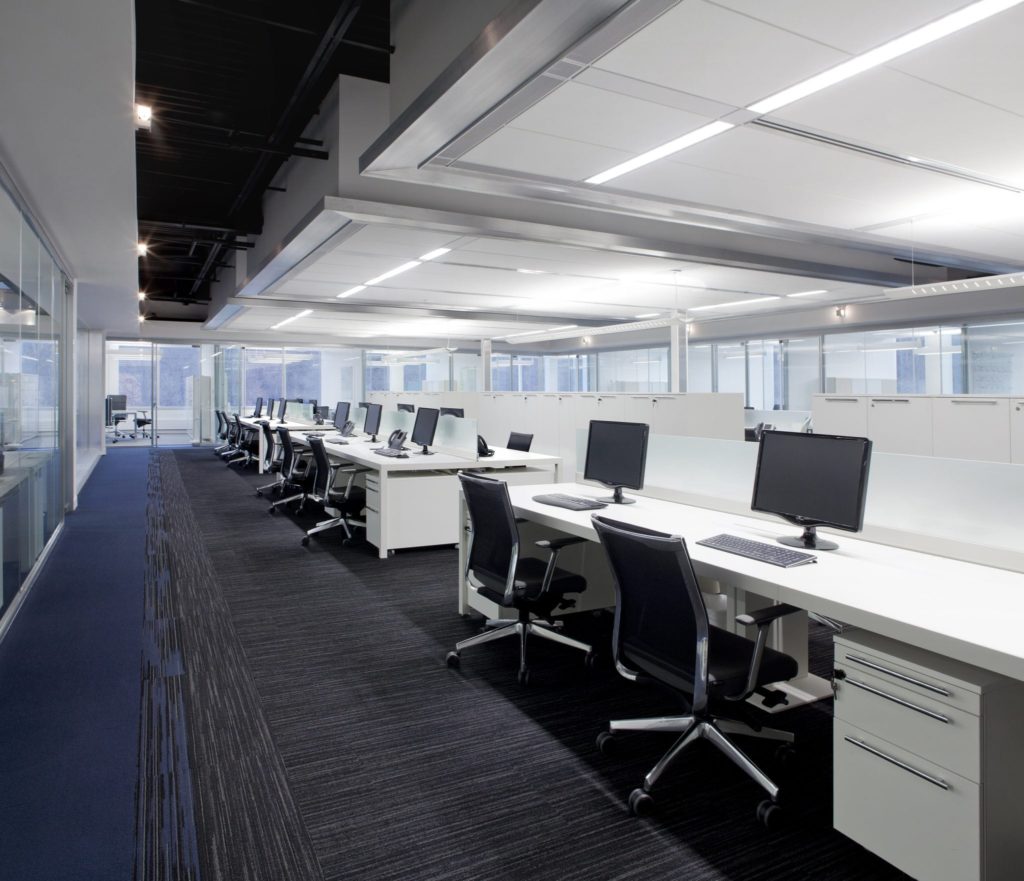
Contemporary office interiors need to make sure to create flexible working areas which make use of long but narrow spaces. By using double-sided desks, this alley of workspaces allows for greater conversation between both sides of the desks while giving each station enough room to move around freely.
Ergonomic Principles
In a modern office, there should be a significant emphasis on ergonomic design principles to prioritize the comfort and well-being of the employees. Organizations are incorporating various ergonomic features and solutions into the workplace, recognizing the detrimental effects of prolonged sitting and repetitive motions. Adjustable desks have gained popularity, allowing employees to alternate between sitting and standing positions throughout the day, promoting better posture and reducing the risk of musculoskeletal disorders. Ergonomic chairs with adjustable height, lumbar support, and armrests are also widely used to provide optimal comfort and reduce physical strain. Additionally, proper lighting is essential for employee well-being, as it affects overall productivity and mood.
By integrating ergonomic design principles, modern office interior design enhances physical comfort and promotes productivity, creativity, and overall satisfaction. Recognizing the connection between a healthy work environment and employee performance, organizations are increasingly investing in ergonomic solutions that contribute to the well-being of their workforce.
Esquire Bank 2
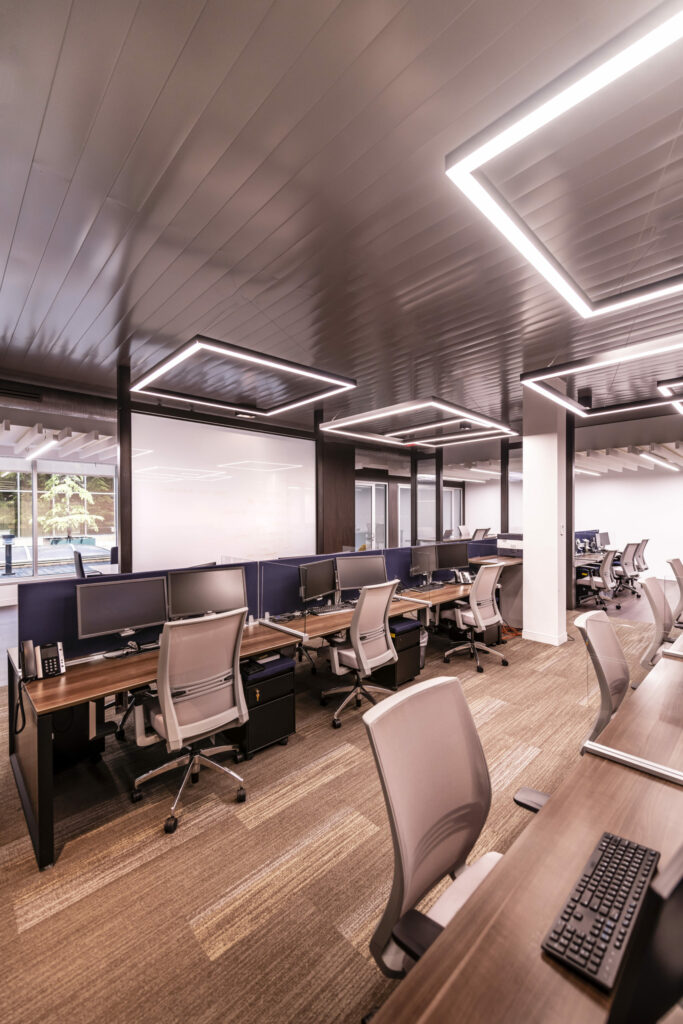
For our second project with Esquire Bank, our interior designers ensured that the desk and chair layouts for the workstations were ergonomic. These chairs are shaped for comfort, reducing stress on the back’s lumbar areas while giving adjustable seat height options. Contemporary office interiors need these considerations while undergoing the design stages.
Spaces for Collaboration and Well-Being
Modern office interior design has begun to incorporate breakout areas, relaxation spaces, and wellness rooms to support the mental well-being of employees. Breakout areas offer alternative workspaces outside the traditional desk setup, providing a change of scenery and encouraging informal collaboration. These areas often feature comfortable seating, whiteboards, and informal meeting spaces to foster creativity and social interaction. Breakout rooms create a safe and comfortable space for people to share new ideas and encourage innovation.
Relaxation spaces, such as cozy lounges or designated quiet rooms, allow employees to unwind, meditate, or take short breaks, helping to alleviate stress and recharge their energy levels. Additionally, wellness rooms are designed to support employees’ physical and mental health needs. These spaces may include amenities like fitness equipment, yoga mats, or even nap pods, allowing individuals to prioritize their well-being during the workday. A modern office is designed in a way that caters outside of the traditional “business needs” and considers the employees and their health.
Esquire Bank 2
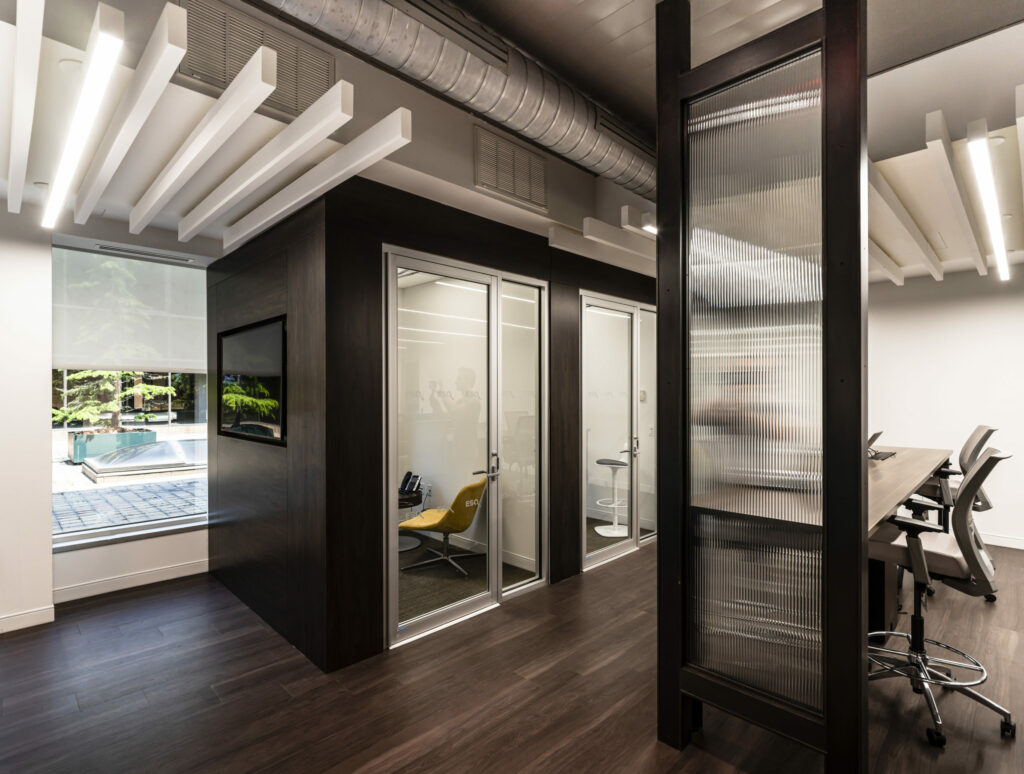
Continuing with the Esquire Bank 2 project, our team created multiple enclosed rooms for individual use. These rooms have chairs and small tables, allowing for flexibility. These can be used for client calls, mental health breaks, or just a space to work in silence. The glass doors ensure transparency while still providing a sound barrier.
Light and Nature
Biophilic design is a concept gaining momentum in modern office interior design. This revolves around the integration of nature and natural lighting into the workspace. It acknowledges the innate human desire to connect with nature and recognizes its positive impact on well-being. In a modern office, biophilic design is achieved by incorporating natural elements such as plants, natural light, and outdoor views. Plants are strategically placed throughout the office, adding aesthetic appeal and improving air quality by purifying the environment. They have been shown to reduce stress levels, increase creativity, and boost productivity.
Natural light, the other crucial element, is prioritized to create a connection with the outside world. Windows that bring in natural light enhance the overall ambiance and provide numerous health benefits. Exposure to natural light helps regulate circadian rhythms, improving sleep patterns and mood. Furthermore, incorporating outdoor views, such as green spaces or landscaped areas, allows employees to enjoy the beauty of nature and provides a sense of calm and relaxation. Biophilic design in contemporary office interiors creates a harmonious and rejuvenating work environment, fostering employee well-being and positively impacting their overall performance and satisfaction levels.
Luxottica Group
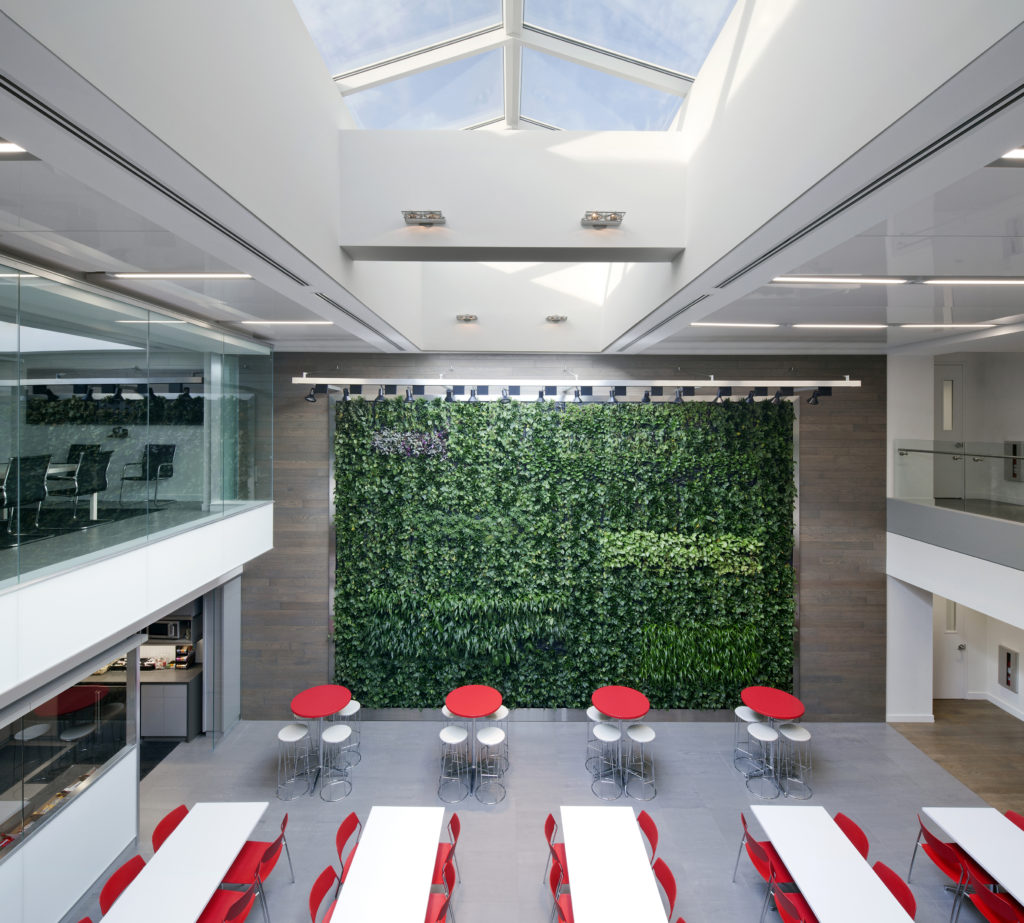
One of the greatest examples of a modern office environment with integrated biophilic design is our Luxottica Group project, where a large cafeteria is centrally located around a massive skylight and a large vertical living plant wall. This space creates a zen-like atmosphere to keep employees calm and engaged throughout their day.
Contemporary Office Interiors by Mojo Stumer
Modern office interior design encompasses various key elements contributing to a well-designed workspace. Open and collaborative spaces, ergonomic considerations, and integrated biophilic design are all design principles that aim to create an inspiring environment for employees. A modern office that is thoughtfully designed can have a profound positive impact on employee productivity, creativity, and overall well-being. Organizations can foster a collaborative and efficient work culture by prioritizing employee comfort, incorporating elements of nature, and providing flexible and adaptable work areas.
By investing in a well-designed workspace, organizations can cultivate an environment that nurtures the potential of their employees and promotes a thriving work culture. If your organization is looking for a modern office environment, contact us today to set up a consultation with one of our architects and interior designers!
